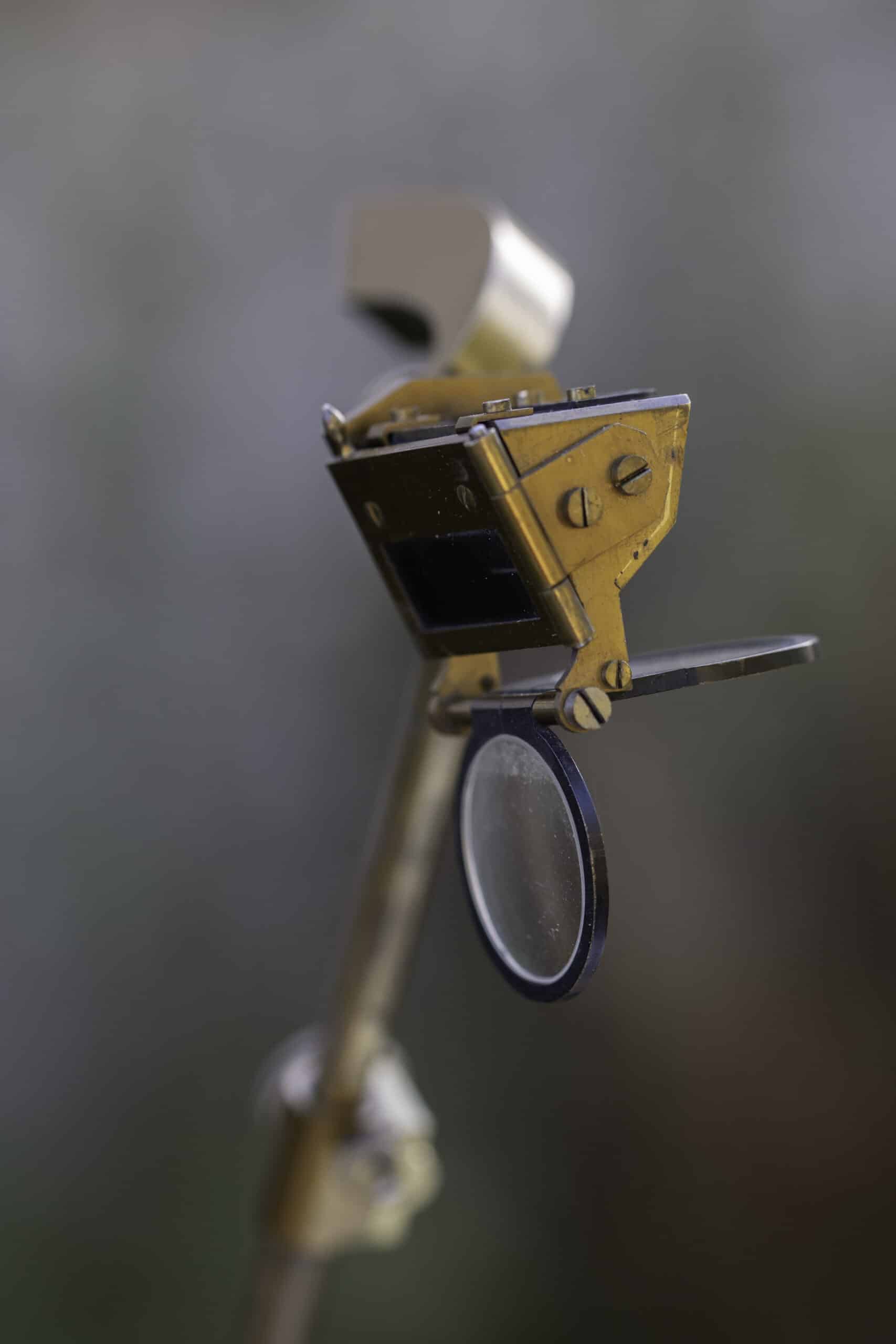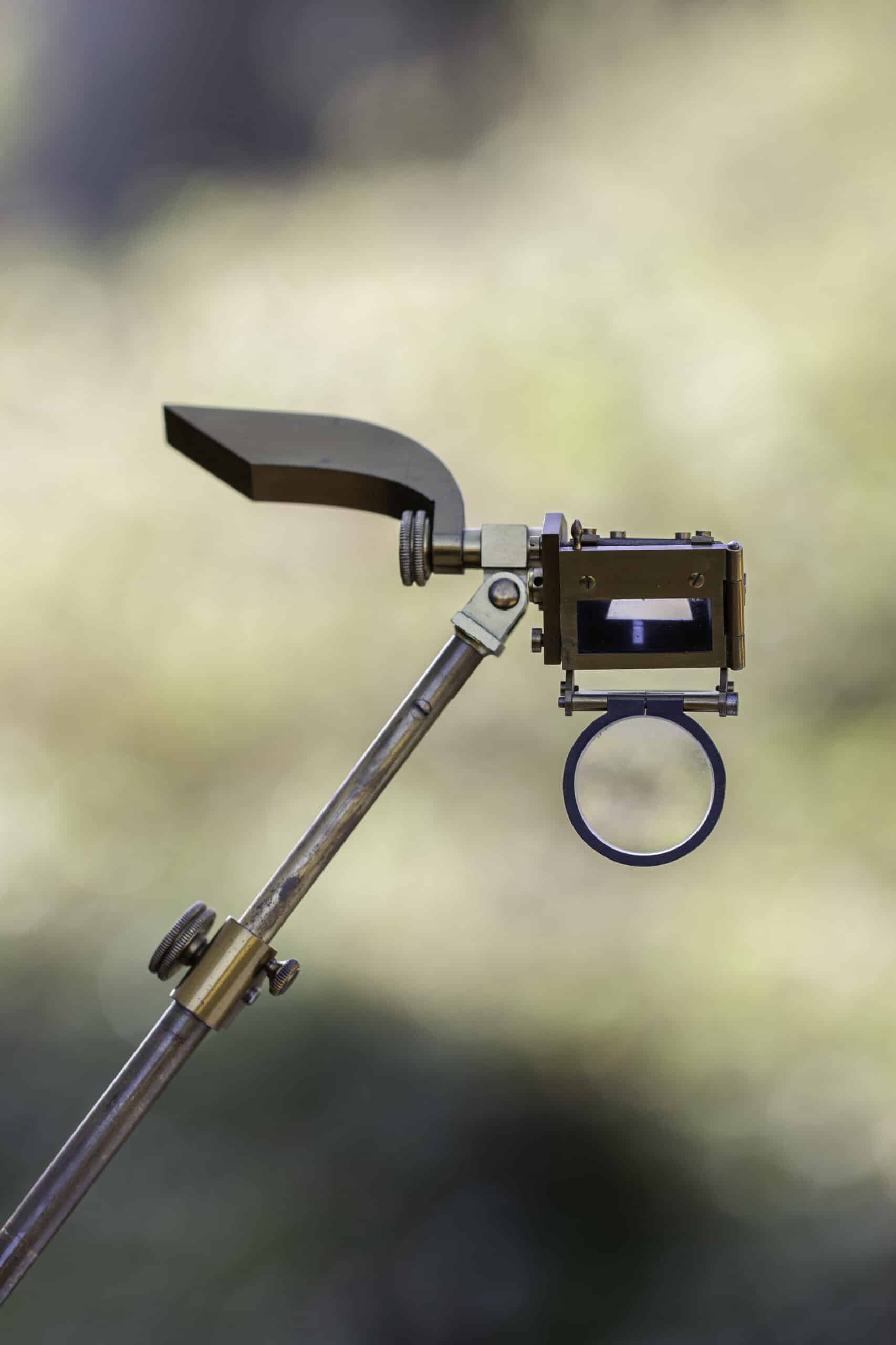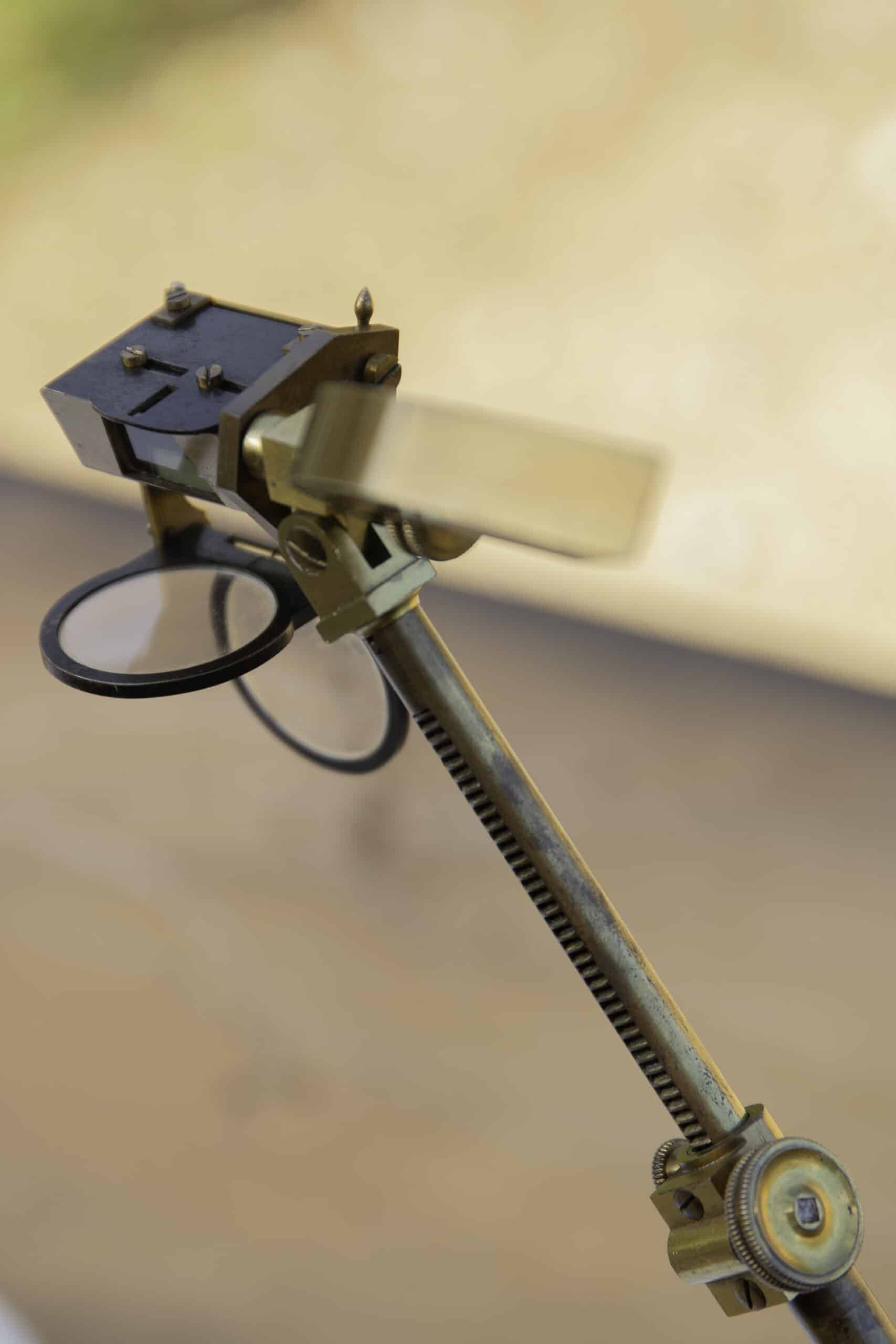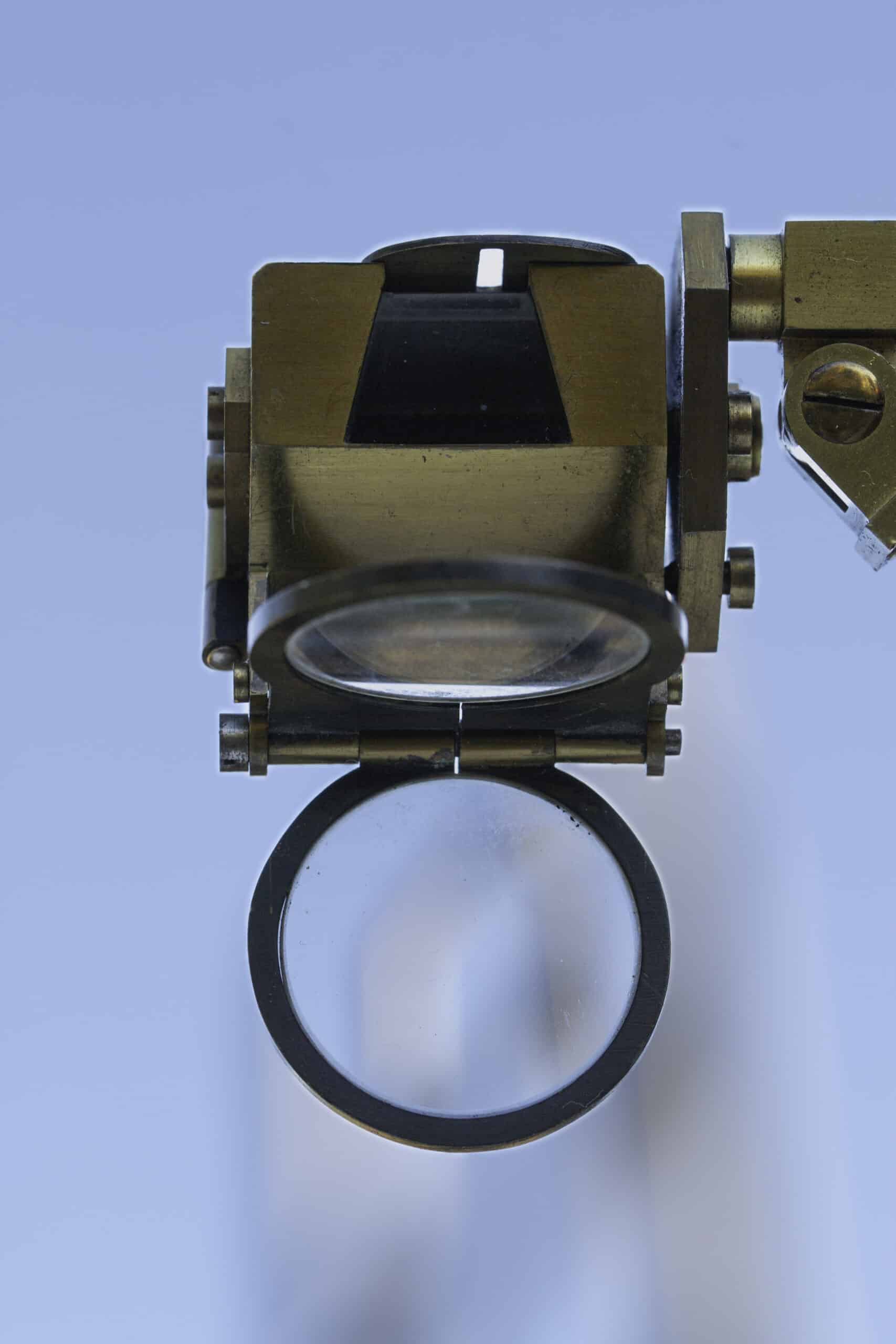DMJ – Brunel’s Camera Lucida
In the Drawing Matter collection there is a camera lucida that belonged to Isambard Kingdom Brunel (1806–1859) (Figs 1–4,6).[1] The camera lucida is an instrument for drawing from life, patented in 1806 by the versatile English chemist and physicist William Hyde Wollaston (1766–1828).[2]

The term camera lucida (‘well-lit room’) is quite misleading. It was presumably coined to contrast with the name of the instrument’s precursor, the camera obscura (‘dark room’).[3] But the camera lucida is not a closed room or box of any kind, instead consisting of a four-sided glass prism supported on a flexible arm. The user lays a sheet of paper flat on a table and looks vertically downwards through the prism, which reflects the object or view to be drawn, so that an image of the subject appears to be superimposed on the paper. With the eye in the correct position, the user can also see his or her hand and pencil directly and thus trace the image.



One might immediately imagine that Brunel found uses for the camera lucida in his work as an engineer, perhaps in surveying the route of the Great Western Railway. There seems, however, to be no evidence that he owned one until the very end of his life. In 1858 he took a long holiday in Switzerland.[4] He brought a sketchbook with him and, during a stay in Lucerne, filled two pages with notes and working drawings of the components of a camera lucida.[5] The Drawing Matter camera carries the name of the well-established London firm of instrument-makers Troughton and Simms. From these sketches by Brunel, it looks as though he might have been thinking about technical improvements to their design (Fig.5).

The struggle to build his gargantuan ocean-going ship the Great Eastern had ruined Brunel’s health, and later the same year he was advised by his doctors to winter in a warmer climate. He went to Egypt accompanied by his wife and younger son Henry Marc. He was also joined by his old friend, the railway engineer Robert Stephenson.
Wollaston arranged for the manufacture of camera lucidas by two firms of instrument-makers, Newman and Dollond, and put them on sale from 1807. They were a big success and were taken up by artists and amateurs for making landscapes and portraits. The camera lucida was much lighter and more easily carried than the camera obscura, and remained in wide use until the 1840s, when it was largely superseded by the photographic camera. David Hockney has argued that J.-A.-D. Ingres used a camera lucida to make his tiny and exquisite pencil portraits of visitors to Rome in the 1810s.[6] Sir Francis Chantrey had front views and profiles of the heads of his sitters drawn with a camera in preparation for his portrait sculptures.[7] The astronomer and mathematician Sir John Herschel—one of the pioneers of chemical photography—was particularly successful in drawing landscapes in Europe and South Africa.[8] Several travellers and explorers took camera lucidas with them to record monuments and curiosities, notably Frederick Catherwood in Central America and Captain Basil Hall in North America.[9]
However, the camera lucida is not an easy tool to master. There is a narrow boundary at which the eye must be placed so that one sees the subject superimposed on the drawing surface. The field of view is small, and it is difficult to see enough of the subject at once to trace long lines smoothly. David Hockney had trouble with the instrument when making portraits, despite his lifelong experience. In the end he used it only for marking the key points in faces which are the secret to getting likenesses, before resorting to drawing directly from the model for most of the detail. The co-inventor of chemical photography Henry Fox Talbot was so disappointed with his own weak and spidery efforts at capturing Italian landscapes with the camera lucida that he became only the more determined to fix the optical image in the camera obscura.[10] Niall Hobhouse and the present author tried to draw with Brunel’s camera in October 2023 but with little success, despite consulting his drawings and notes and experimenting with various adjustments of the component parts.

Isambard’s son, Henry Marc, wrote a diary of their travels in Egypt.[11] On 20 January 1858 they visited the temple complex at Dendera on the Nile. Isambard got out his camera lucida and started to draw but found it was not in working order and made the sketch without it. There appears to be no record of anyone ever successfully using Brunel’s camera lucida, not even its owner. Brunel went back to England and died in September that year.
Notes
- Drawing Matter Collections: 2724.
- British Patent No 2993 was granted in 1806 to William Hyde Wollaston for ‘An Instrument whereby any person may draw in Perspective, or may Copy or Reduce any Print or Drawing.’
- For a comprehensive history see John H. Hammond and Jill Austin, The Camera Lucida in Art and Science (Bristol: Adam Hilger, 1987). Brunel is however not mentioned.
- Isambard Brunel, ‘Chapter XVII: Private Life’, in The Life of Isambard Kingdom Brunel, Civil Engineer(London: Longmans, Green and Co, 1870). The author was the engineer’s elder son.
- Isambard Kingdom Brunel, sketchbook kept at Lucerne 1858, folios 37 and 38; in Brunel Collection, Bristol University Library, DM 162/8.
- David Hockney, Secret Knowledge: Rediscovering the Lost Techniques of the Old Masters, 2nd edn (London and New York, 2006), 28–31.
- Helen Smailes, ‘Thomas Campbell and the “camera lucida”: the Buccleuch statue of the 1st Duke of Wellington’, The Burlington Magazine, vol.129 (1987), 709–714.
- Larry J. Schaaf, Tracings of Light: Sir John Herschel & the Camera Lucida, Drawings from the Graham Nash Collection (San Francisco: The Friends of Photography, 1989).
- Frederick Catherwood, Views of Ancient Monuments in Central America, Chiapas and Yucatan (London: published by the author, 1844); Captain Basil Hall, Travels in North America, in the years 1827 and 1828, 3 vols (Edinburgh and London: Simpkin and Marshall, 1830).
- Martin Kemp, ‘Talbot and the picturesque view: Henry, Caroline and Constance’, History of Photography, vol.24 (1997), 270–282.
- Henry Marc Brunel, diary entry for 20 January 1859, in Brunel Collection, Bristol University Library, DM 162/6/5.
Philip Steadman is Emeritus Professor of Urban and Built Form Studies at University College London. He trained as an architect and has taught at Cambridge University and the Open University. In the 1960s he co-edited and published Form, a quarterly magazine of the arts. He has contributed to numerous exhibitions, films and books on perspective geometry and the history of art. In 2001 he published Vermeer’s Camera (Oxford University Press), on the Dutch painter’s use of the camera obscura. The full-length documentary film Tim’s Vermeer (Sony Pictures, 2014) was largely inspired by Vermeer’s Camera. In 2022 he was awarded an Emeritus Fellowship by the Leverhulme Trust for a project on Canaletto and the camera obscura. He is working on a book to be called Canaletto’s Camera.
The article is included in the second issue of DMJournal, Drawing Instruments: Instrumental Drawings.
